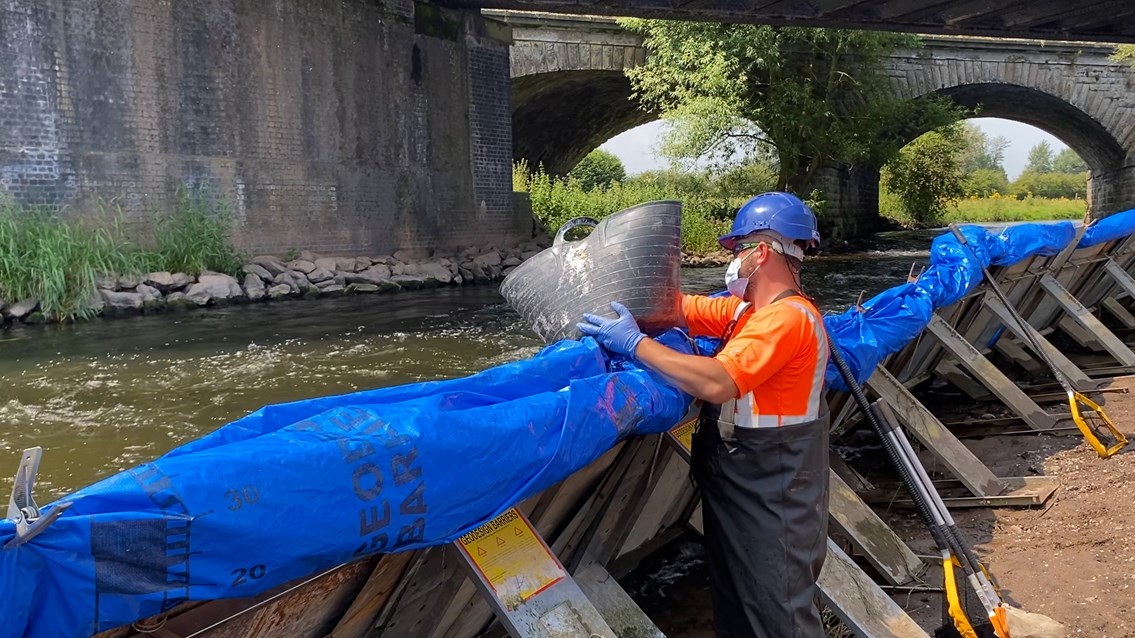Friday 3 Sep 2021
Fish rescued from River Trent during major railway viaduct upgrades
- Region & Route:
- North West & Central
Ecologists are relocating fish in the River Trent during work to protect two major railway viaducts on the West Coast main line.
Network Rail is carrying out the £1.4m repairs at Rugeley in Staffordshire to make journeys for passengers and freight safe and reliable on this crucial section of railway line.
Fast flowing river water has caused erosion, or scour, to the viaduct’s structural supports.
Now the river is being diverted and drained around the supports so that pieces of rock weighing up to three tonnes can be laid to protect them from further erosion.
This is being done by carefully damming one half of the river at a time with ecologists making sure no wildlife is harmed during the essential work.
As the water is lowered, any fish which become trapped are safely caught and released into the open river.
It’s one of the biggest river diversion projects of its kind to be carried out by Network Rail*.
Andrew Campuzano, ecologist for Network Rail, said: “Because of the scale of the work needed on this railway viaduct we’ve had to completely drain sections of the River Trent to improve journeys for passengers and freight.
“I’ve planned and carried out a number of fish relocations before, but this is one of the biggest and more ambitious so far. We take great care to make sure the fish are not distressed by this process and they are completely unharmed when they are released back into the water.”
So the fish are not distressed, they are gently stunned using a low electric current which passes through the water so they can be caught in nets.
They are then placed in a bucket and logged before they are released back into the main river.
More than 8000 tonnes of rock is being used to protect the bases of the viaducts’ structural supports.
The work will protect future journeys on the West Coast main line above, which is one of Europe’s busiest mixed-use passenger and freight railway lines.
Ben Clarke, scheme project manager for Network Rail, said: “There’s never been a more important time to keep goods and people moving around the country and this railway viaduct work on one of Britain’s most economically important rail routes does exactly that.
“But while we always concentrate on keeping the railway safe and reliable for passengers and freight, we are likewise committed to making sure any work we do has minimal impact on the environment. That’s why we are taking such great care to rescue and relocate the river’s wildlife during this major work.”
The river damming work has taken place in two phases and began in July.
Species rescued in the first phase included eels, trout and lamprey.
The project was planned during the summer when river levels are at their lowest and also when fish aren’t migrating upstream to spawn.
Another environmental consideration is that the worksite is solar and hydrogen powered to reduce carbon emissions.
The work is expected to be complete by October so the railway viaduct protected in time for the winter.
To find out more about how Network Rail takes care of the environment while repairing the railway visit: https://www.networkrail.co.uk/communities/environment/wildlife/
Notes to Editors
*This is one of the largest river diversion projects using a ‘cofferdam’ system ever carried out by Network Rail. A cofferdam is a watertight enclosure from which water is pumped to expose the bottom of a body of water and permit construction.
Contact information
Passengers / community members
Network Rail national helpline
03457 11 41 41
Latest travel advice
Please visit National Rail Enquiries
Journalists
Network Rail press office - North West & Central Region
0330 854 0100
NWCmediarelations@networkrail.co.uk
About Network Rail
We own, operate and develop Britain's railway infrastructure; that's 20,000 miles of track, 30,000 bridges, tunnels and viaducts and the thousands of signals, level crossings and stations. We run 20 of the UK's largest stations while all the others, over 2,500, are run by the country's train operating companies.
Usually, there are almost five million journeys made in the UK and over 600 freight trains run on the network. People depend on Britain's railway for their daily commute, to visit friends and loved ones and to get them home safe every day. Our role is to deliver a safe and reliable railway, so we carefully manage and deliver thousands of projects every year that form part of the multi-billion pound Railway Upgrade Plan, to grow and expand the nation's railway network to respond to the tremendous growth and demand the railway has experienced - a doubling of passenger journeys over the past 20 years.
Follow us on Twitter: @networkrail
Visit our online newsroom: www.networkrailmediacentre.co.uk

